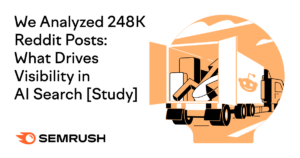An Amazon PPC expert is a digital marketing professional or agency that specializes in managing Amazon campaigns. Our editors have reviewed and vetted the best experts in the industry to help you find the best match for your brand.
Amazon accounts for nearly 40% of the U.S. online retail market, making it a highly competitive ecommerce platform.
To stand out, many brands partner with an Amazon pay-per-click (PPC) expert to help refine their strategy, stretch ad dollars further, and boost their return on ad spend (ROAS).
To help you find the right partner, we’ve rounded up the top Amazon PPC experts trusted by brands across industries — with expert insights from HawkSEM Team Lead Melissa Torre.
Top 7 Amazon PPC experts
Ready to find the right partner to manage your Amazon PPC ads?
Check out these top Amazon PPC experts, primed and ready to help you refine your strategy, increase your sales, and improve your efficiency.
- Logical Position
- Jellyfish
- HawkSEM
- AMZ Pathfinder
- Ad Badger
- Booyah
- Sellozo
1. Logical Position
Founded in 2010 in Oregon, Logical Position is another high-end advertising agency with a broad scope of services.
They handle PPC, search engine optimization (SEO), web design, graphic design, analytics, and social media.
They also boast impressive numbers, having managed $2.15 billion in ad spend across all platforms. Logical Position focuses on fine-grained control over the ads they manage.
Best for: Electronics, bath and body, home decor, cosmetics
2. Jellyfish
Jellyfish is a modern agency for a modern world. With over 50 certified Amazon experts on their team, Jellyfish helps boost visibility on the ecommerce mega-site.
No stranger to working with big brands with significant needs, their client roster includes names like eBay, Ford, Disney, Samsung, LG, and Uber.
Best for: Fashion, cosmetics, lifestyle, technology
3. HawkSEM
HawkSEM (that’s us) has been helping brands maximize their return on investment through a data-driven, hands-on approach for over fifteen years.
With a 98% retention rate and an average 4.5X ROI, our team of seasoned PPC experts knows how to build custom strategies that drive stronger campaigns and lasting growth.
HawkSEM’s Amazon PPC management services include:
- Two new Amazon advertising campaigns per month
- Campaign audit
- Competitor and market analysis
- Keyword research
- Amazon SEO
- Product page optimization
- Top 20 product optimization
- Ongoing campaign buildouts
- Weekly product feed and store updates
- Amazon store setup and maintenance
- Monthly promotion launches
- Brand expansion updates
- Inventory sync, listings, and item upkeep
- Account health monitoring and consulting
- Monthly reporting and recommendations
Fueling these efforts is ConversionIQ: our proprietary technology that delivers insights that reduce wasted spend and drive more sales.
Best for: B2B, B2C, Ecommerce, SaaS, Finance, Healthcare, Education, Professional Services
4. AMZ Pathfinder
Unlike the other agencies on this list, AMZ Pathfinder is a PPC management agency that focuses exclusively on Amazon.
Additionally, AMZ Pathfinder only works with brands that bring in at least $100,000 per month in revenue.
Companies that fit that profile can contact them for a free consultation and to learn more about pricing.
Best for: Amazon-only brands
5. Ad Badger
Ad Badger started as a general PPC service provider before shifting its focus to Amazon, after recognizing how many brands struggled with the platform.
Today, their Amazon management service includes daily bid optimization, ASIN checks (Amazon Standard Identification Number), and weekly keyword research — all with a transparent approach to reporting and campaign adjustments.
Brands need a minimum monthly ad spend of $10,000 to work with them, but for companies that prefer more in-house control, Ad Badger also offers an Amazon PPC optimization app.
Best for: Amazon businesses spending over $10,000 per month
6. Booyah Advertising
Based in Denver, Colorado, Booyah Advertising offers an array of Amazon marketing services, including SEO and content optimization, sponsored ads, Amazon DSP advertising, account audits, and Amazon-specific strategy.
Their philosophy centers on “driving growth through an advertising-focused strategy that spins every part of the Amazon flywheel.”
Rather than operating in silos, Booyah integrates Amazon campaigns into a holistic digital marketing strategy that uplifts your ecommerce program as a whole.
They also connect Amazon strategies with broader initiatives such as paid and organic media, web design, video, and pitch deck development.
Best for: Food, lifestyle, outdoors, and fashion brands
7. Sellozo
Sellozo sets itself apart in the crowded Amazon PPC space with proprietary AI technology designed to expand client reach and maximize performance.
Their services include AI-driven bid automation, advanced keyword strategies, and comprehensive analytics. With a fully data-driven approach, Sellozo ensures every element of an Amazon campaign is optimized for growth and efficiency.
Best for: Sports, lifestyle, and fashion brands
What is an Amazon PPC expert?
An Amazon PPC expert is a digital marketer or agency that specializes in Amazon’s pay-per-click advertising platform.
Amazon PPC experts have a comprehensive knowledge of campaign management on Amazon’s unique PPC model, which includes:
- Brand ads that appear at the top of the Amazon search results page
- Sponsored product ads that appear in the search results as high-listed promoted product listings
- Sponsored display ads that appear as Amazon Sponsored Ads or display ads off-Amazon in their publisher network (or on Twitch, which Amazon owns)
Their expertise typically includes keyword research, bid management, product listing optimization, ad campaign strategy, and performance analysis, all with the goal of maximizing ROAS and reducing wasted ad dollars.
How do Amazon’s PPC ads work?
Amazon ads work on a cost-per-click (CPC) model. When a shopper searches using keywords relevant to your product, your ads become eligible to appear.
In Seller Central, advertisers track four key performance indicators (KPIs) or metrics:
- Impressions: The number of times your ad is shown to shoppers
- Clicks: The number of times shoppers click on your ad
- Attributed Sales: Sales that occur within seven days of someone clicking your ad
- Advertising Cost of Sales (ACoS): The percentage of revenue spent on ads (for example, if you spend $50 on ads and generate $500 in sales, your ACoS is 10%)
Another key metric is return on ad spend (ROAS), calculated as the total value of ad-attributed sales divided by the entire ad spend.
While Amazon doesn’t provide this number directly, it’s worth tracking since it shows how much revenue you earn for every dollar invested.
Ultimately, the better your targeting and campaign structure, the higher your ROAS.
But with countless variables at play, it’s easy to waste ad-spend budget if campaigns aren’t set up correctly. That’s why many brands turn to Amazon PPC experts.
How much does an Amazon PPC expert cost?
An Amazon PPC expert can range from $1500 to $5000 a month depending on needs. While an expert’s experience will ultimately dictate their value, other factors will impact cost, including:
- Competition: Competitive product categories lead to a higher CPC
Target keywords: Broader, high-volume keywords will be more expensive - Ad types: Similarly, different ad types will have different costs
- New campaigns and optimization: New campaigns often cost more until they are optimized
- Seasonality: Busy shopping seasons (holiday, major sales) can increase bidding pressure
How to optimize Amazon PPC campaigns
If hiring an Amazon PPC specialist isn’t something you can afford yet, there are steps Amazon sellers can take to make the most of their campaigns.
Our experts offer their top tips for campaign optimization:
1. Add negative keywords
Negative keywords keep your ads from showing for irrelevant products.
The best way to add negative keywords is to check your Amazon Search Terms Report to find any terms you might like to exclude.
This report includes helpful information, including campaign name, ad group name, portfolio name, keyword match type, and click rate.
2. Improve landing pages
For Amazon PPC ads, a landing page can be a video landing page, a text and image-based page about your product, or product pages.
To improve the performance of your landing pages, use keywords in your titles and your copy. Ensure all images are clear and you have a single, compelling call to action (CTA).
“We want to ensure that all titles, bullet points, and backend keywords are as complete as possible,” says Torre.
Torre reminds us that there should be at least five images on the listing; they can be lifestyle images, product closeups, packaging, or infographics.
“If you are a registered brand owner, ensure your A+ descriptions are built and the Amazon Landing Page has been created and optimized with creative images, features, and benefits,” she says.
This way, once it is time to run PPC in Amazon, the ads and keywords will match the terms on the product pages, which helps streamline algorithm learning.
3. Conduct keyword research
Keyword research will help you choose the right keywords for your campaigns. It’s best to develop a strategy based on your product and your competitor research before starting your keyword research.
To perform keyword research:
- Use the Amazon search bar to get suggestions from Amazon (autocomplete)
- Choose a tool like SEMrush
- Find a specialized keyword research tool for Amazon
- Mine Google Trends
“There are plenty of third-party tools you can use, such as Helium 10 and Keywords Everywhere,” says Torre. “But you can also just start searching in the Amazon UI for ideas.”
She says that when a customer is also running Google or Bing PPC, we can apply keyword learnings from previous performance.
“Make sure to check for synonyms and look at competitors’ titles and bullet points for ideas,” she says.
4. Choose the right match types
Match types determine how closely a shopper’s search query must align with your keywords. Selecting the wrong type can waste money and attract unqualified traffic.
Amazon offers three match types:
- Broad match: Triggers ads when any of the keyword’s terms appear in a query, in any order. Broad match drives higher traffic and works well for top-of-funnel campaigns, but bids can be more expensive.
- Phrase match: Shows ads when a query includes your keywords in the same order, with additional words allowed before or after. For example, “blue running shoes” can match the keyword “running shoes.” This type is best for mid-funnel consideration and conversions.
- Exact match: Displays ads only when queries exactly match your keyword (or close variants like plurals). While exact match yields lower traffic, it often drives higher-quality clicks, making it ideal for pulling proven terms from your Search Terms Report.
5. Select appropriate audiences
Audiences are important to Amazon’s Sponsored Display Ads. These ads use Amazon shopping signals to find users who are most likely to buy or interact.
The best way to choose audiences is to develop an ideal customer persona and match that persona to the audiences available to you.
For instance, someone who just moved might be looking for dinnerware. This same audience could also be newly married.
Audiences are grouped by these categories:
- Lifestyle: Here, you’ll find people whose shopping and watching behavior shows an interest in a certain type of lifestyle. This could refer to shows they’ve consumed or indicated an interest in on Amazon Prime, IMDB, or browsing history on Amazon.
- In-market: In-market audiences are shoppers who are looking to buy specific products, as gauged by their behavior.
- Life events: These are the life events people experience, like moving, getting married, graduating, etc.
- Interests: These are activity-based. Interests come from recent activity on Amazon.
6. A/B test and experiment
A/B testing is an essential way to learn and scale. Amazon presents a dilemma, though: there’s no easy way to conduct A/B testing as you would in platforms like Google.
Torre explains, “We do not have an easy experiment setup program like in Google Ads, but I like to run a placement test for top of page in a campaign to try for better low funnel performance.”
Without a native A/B testing feature, Torre recommends using creative workarounds. For example, you can:
- Launch auto campaigns, then use that data to create new campaigns with looser match types to discover new placements and search terms.
- Run those alongside stricter match campaigns to compare audience and performance differences.
- Test variations in ad copy across campaigns to see which resonates best.
Since Amazon doesn’t have a specific tool, you’ll need to be creative when testing — but it’s still a powerful way to uncover insights and improve performance.
The takeaway
Like other PPC advertising platforms, Amazon requires regular maintenance and a hands-on approach to reach your target audience and increase revenue.
But with millions of products sold on the Amazon marketplace, and a rapidly changing platform with its own algorithm and competitors, getting ahead and hitting your business goals can be challenging.
If your brand needs help with its Amazon PPC advertising strategies and ads management, consider partnering with one of the experts on our list.
From boosting conversion rates and brand awareness to optimizing Amazon listings and campaign performance — the right Amazon PPC agency can turn searchers into loyal customers.
This article has been updated and was originally published in January 2023.







